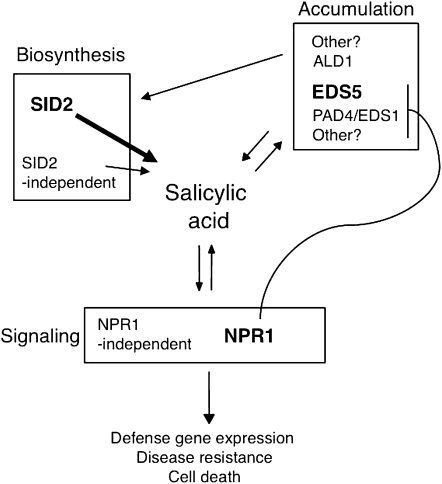Figure 8 .
SA-mediated defense signaling networks. SA represents a key hub on the defense signaling networks. Genes regulate SA-mediated defense can be viewed in three types. Type I genes are responsible for SA biosynthesis, with SID2 contributing to the major SA production and SID2-independent pathway playing a minor role. Type II genes encode protein products that do not act directly as SA biosynthetic enzymes. It is possible that these SA regulators might influence SA biosynthetic processes by either modifying the activities of the SA biosynthetic enzymes or regulating precursor availability for SA biosynthesis. Alternatively, they can affect SA stability, sequestration, transport, and/or conjugation. Among the known type II SA genes, EDS5 plays a major role in regulating SA accumulation. Other components also partially affect SA levels. Type III genes include NPR1 as the main SA signal transducer and other signal transducers independent of NPR1. Expression of some SA regulatory genes is known to be regulated by SA, suggesting the existence of multiple signal amplification loops involving SA and SA regulatory genes. In this report, we described a genetic analysis based on the defense-sensitized mutant acd6-1 to elucidate the functional relationships among the SA genes. We showed that the same type of SA genes can additively interact with each other and they can also additively interact with other types of SA genes to affect SA accumulation, defense gene expression, disease resistance, and/or cell death phenotypes in the acd6-1 background. Nonadditive interactions were observed between EDS1 and PAD4 and between ALD1 and NPR1.

